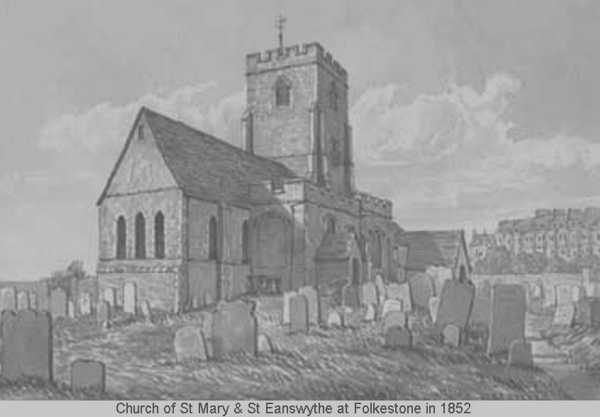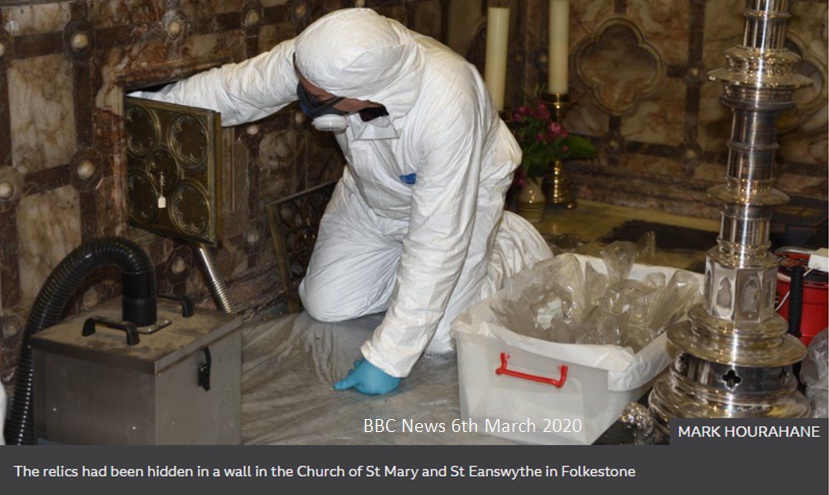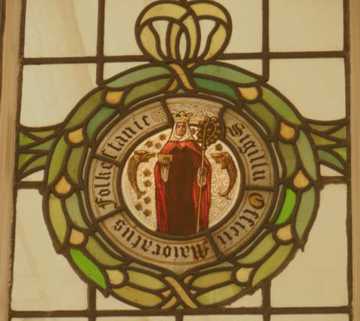| Saint
Eanswythe: The Patron Saint of the Ancient Harbour Town of Folkestone |
|
|
|
|
|
|

The remains of the buildings that St. Eanswythe would have known have now been lost, however St Eanswythe is remembered by the Church of St Mary & St Eanswythe. Tradition has it that St Eanswythe remains was saved by the nuns and secretly hidden.
On 17th June 1885 a discovery was made by workmen preparing the wall o f the Sanctuary of an old decayed leaden coffer in which were a number of bones it was believed these were the remains of Saint Eanswythe.

The report of an examination of the relics of St. Eanswythe in Folkestone Parish Church By Dr. P.H.Garrard, M.B., B.S., on 29th February 1980. Notes taken from Canon Scott Robertson, Honorary Secretary of the Kent Archaeological Society, article in " Archaeologia Cantiana, XVI " suggest that the remains of a female of 5ft 4in height and aged between 18 to 25 years could possibly well be St Eanswythe. Mr T.Tatton-Brown, Director of the Canterbury Archaeological Trust suggested that "The only way we could really confirm, or not, the attribution of the bones as being those of St. Eanswythe is to use one small bone for Radio Carbon dating (this would destroy that particular bone) and I think it would be well worth doing."
A public meeting at the church was held on Monday 6th June 2016, to discuss a project called “Finding St. Eanswythe”, which was to carry out Radio Carbon dating of the remains. However as St Eanswythe was a Royal Princess the remains like the alleged remains of possible one or both ‘Princes in the Tower’ project to do carbon dating on the remains might not be granted the Queen’s Royal Approval.
7th March 2020, we learn of the desecration of the shrine of Saint Eanswythe at Folkestone & the removal of teeth and bone for DNA – Click here for link.
On Thursday 13th May 2021, a Canterbury Archaeological Trust's 'Zoom' meeting was held with Dr Andrew Richardson, the talk was an update about 'The Finding Saint Eanswythe Project'. A tooth and bone samples were removed from the remains of allegedly relics of Saint Eanswythe, for DNA, Carbon-14 dating. The reported findings in January 2020 which indicated the remains of the person was around 22 years (could be seen in the jawbone X-ray which showed that the wisdom tooth was unerupted).
The DNA findings indicated the remains had been that of a person born around a probable date of AD633 to AD641, whose death was around a probable date of AD653 to AD663. In the 29th February 1980 examination of the ‘relics’ by Dr P.H.Garrand reported that the angle of the sciatic notch is wide (estimated at nearly 90 degrees). These findings are consistent with a female skeleton. This was not supported in the recent findings.
The reported findings (AD2020) on the bone and teeth samples taken from remains did not confirm to the understanding of the historic the life of Saint Eanswythe as is commonly believed. Which is that she became Abbess of a religious community of Sisters in AD630, did not match with a female born between AD633 to AD641.
So are these the remains of Saint Eanswythe the Patron Saint of Folkestone? If this can be proven then the history of Folkestone and Kent needs to be rewritten. Perhaps as the first nunnery of England had many 'Sisters' who when they passed away their remains were seemly was treated in the same way as Eanswythe’s. It could be that the human remains found on St Alban’s Day 17th June 1885, are not of Saint Eanswythe but those of a Sister of that place?
Further analysis of the bones and teeth might support for additional findings of Carbon-14 dating, such as ‘isotopic analysis' could furnish us with details of her local geology, and diet, to enable us to possibly pinpoint where ‘she’ was born and had lived and what food was to be found where she lived, this reseach might some day, go some way to solve the Saint Eanswythe’s Mystery.

